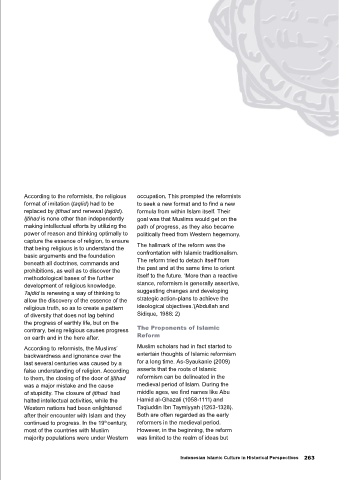Page 273 - INDONESIAN ISLAMIC CULTURE IN HISTORICAL PERSPECTIVES
P. 273
the colonial government provideda they joined the Masjumi. Among them, According to the reformists, the religious occupation. This prompted the reformists
European style of education: the to mention some names, were H.O.S. format of imitation (taqlid) had to be to seek a new format and to find a new
Hollandsch Inlandsch School Cokroaminoto, Agus Salim, Kasman replaced by ijtihad and renewal (tajdid). formula from within Islam itself. Their
(HIS) for the primary level, Meer Singodimejo, Mohammad Roem, and Ijtihad is none other than independently goal was that Muslims would get on the
Uitgebreid Lager Onderwijs (MULO) Mohammad Natsir. making intellectual efforts by utilizing the path of progress, as they also became
for the junior intermediate level, and power of reason and thinking optimally to politically freed from Western hegemony.
Algemene Middelbare School (AMS) It should be added that in Muslim capture the essence of religion, to ensure
for the senior secondary level. In the societies in Western colonies a sort of that being religious is to understand the The hallmark of the reform was the
following period it also established the secularization process had taken place basic arguments and the foundation confrontation with Islamic traditionalism.
College of Engineering (Technische under the influence of the Western beneath all doctrines, commands and The reform tried to detach itself from
Hogeschool/THS) in Bandung, and the educational system, both for those prohibitions, as well as to discover the the past and at the same time to orient
Rechtshogeschool (RHS) in Batavia. who were studying in their homeland methodological bases of the further itself to the future. ‘More than a reactive
In addition, since the end of the 19 th and those who were sent to study in development of religious knowledge. stance, reformism is generally assertive,
century, there had been a medical high the West. The reformer group of Islam, Tajdid is renewing a way of thinking to suggesting changes and developing
school, the School tot Opleiding voor as Western reformists, was open to allow the discovery of the essence of the strategic action-plans to achieve the
InlandscheArtsen (STOVIA), and the accommodation and assimilation. It religious truth, so as to create a pattern ideological objectives.’(Abdullah and
school of governmental science for the wanted to produce a new synthesis of diversity that does not lag behind Sidique, 1988: 2)
native civil servants, Opleiding School between Islam and modern science the progress of earthly life, but on the
voor Inlandsche Ambtenaren (OSVIA). and technology. So, reformers tried contrary, being religious causes progress The Proponents of Islamic
Young Indonesian Muslim children to distance themselves from two on earth and in the here after. Reform
gradually started to enter modern orientations: old-fashioned and stagnant According to reformists, the Muslims’ Muslim scholars had in fact started to
European schools, which slowly Islam, and from admiring Western backwardness and ignorance over the entertain thoughts of Islamic reformism
affected their modern way of thinking. secular civilization that only saw religion last several centuries was caused by a for a long time. As-Syaukanie (2009)
asan individual phenomenon (Esposito,
The children who entered modern 1999: 647). false understanding of religion. According asserts that the roots of Islamic
public education were partly influenced to them, the closing of the door of ijtihad reformism can be delineated in the
by a Western secular way of thinking The emergence of the reform movement was a major mistake and the cause medieval period of Islam. During the
and some became anti-Islamic and in Indonesia was partly characterized of stupidity. The closure of ijtihad had middle ages, we find names like Abu
behaved like Europeans, while others by the establishment of modern halted intellectual activities, while the Hamid al-Ghazali (1058-1111) and
took advantage of rational thinking to organizations for structurally well-planned Western nations had been enlightened Taqiuddin Ibn Taymiyyah (1263-1328).
comprehend their religion (i.e. Islam) activities. These organizations are the after their encounter with Islam and they Both are often regarded as the early
better. Members of this group later Sarekat Islam (1911), the Muhammadiyah continued to progress. In the 19 century, reformers in the medieval period.
th
became the forerunners of Islamic (1912), Al-Irsyad (1915), and also most of the countries with Muslim However, in the beginning, the reform
modernism and after Independence Persatuan Islam or Persis (1923). majority populations were under Western was limited to the realm of ideas but
262 Indonesian Islamic Culture in Historical Perspectives Indonesian Islamic Culture in Historical Perspectives 263

